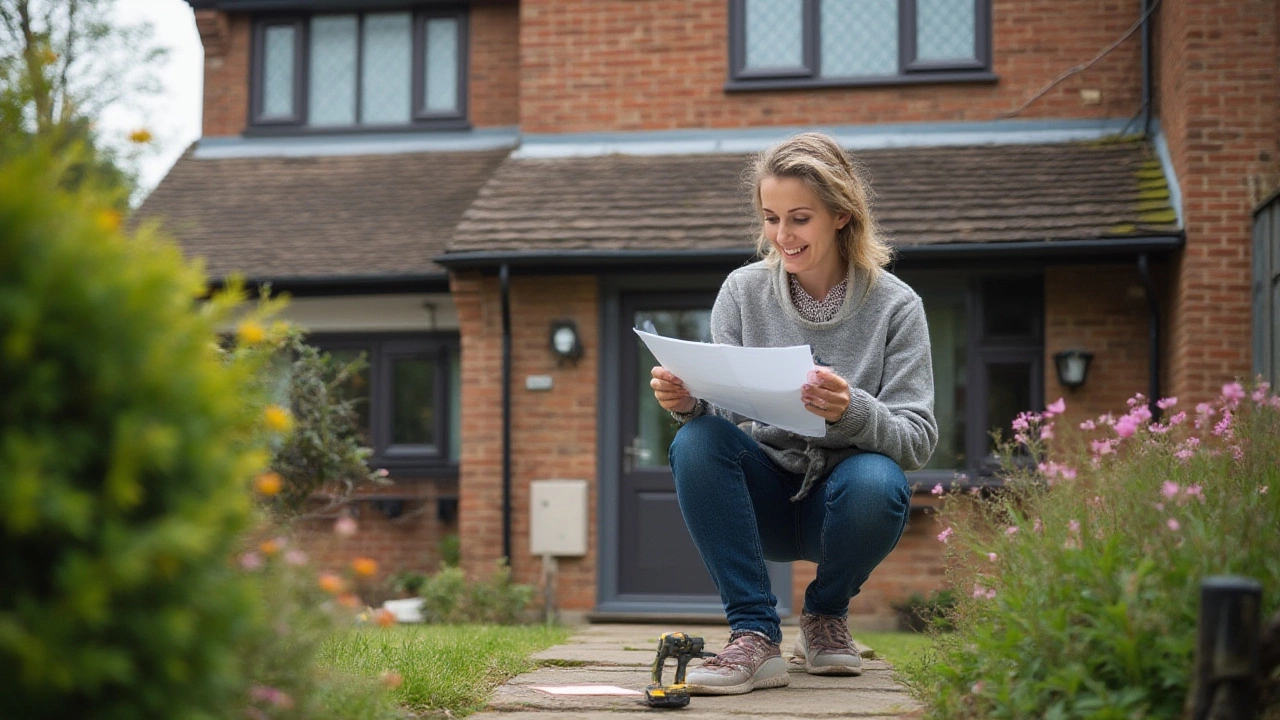Your doorbell knows more about your daily life than you think. It tracks every visitor, the Amazon guy’s pre-sprint face, and even your neighbour’s dog, who's become a bit too familiar with your front porch. When you swap the old 'ding dong' for a shiny new Ring Doorbell, you don’t just get smarter notifications— you get a digital peephole, 24/7. But then comes the head-scratcher: do you actually need an electrician to install a Ring device in the UK, or can you handle it solo?
What Makes a Ring Doorbell Different?
Traditional wired doorbells haven't changed much since grandma's days. You've got a button, a couple of wires, and a chime. Smart doorbells like Ring crank it up a notch. Now, you’re dealing with Wi-Fi, motion sensors, HD cameras, night vision, and live feeds to your smartphone. This sounds complicated, but Ring has always pushed the idea that anyone can do it with a bit of patience and a screwdriver.
Here's a key fact: There are two main types of Ring Doorbells—the battery-powered ones and the hardwired versions. Battery-powered models like the Ring Video Doorbell 2 and 3 need nothing more than a drill and a few screws. Hardwired models, like the Ring Video Doorbell Wired or Pro, expect a power connection. In the UK, this means linking them to the existing doorbell wiring or, in some setups, a plug-in transformer. That “hardwired” word is what trips people up.
Ring says their devices are made to be user-friendly, and their app tutorials are about as simple as a flat-pack instruction. But houses in the UK vary wildly: Victorian terraces, 1960s semis, and everything between. Some have doorbell wiring that’s as mysterious as Stonehenge, others were never wired for a bell at all. That’s where things can get tricky, especially if you’re dealing with old electronics or non-existent wires.
Another big difference to mention: Ring Video Doorbell devices aren’t just for ringing visitors. They can record, notify, and even let you speak to someone at your door when you’re not home. This makes installation matter even more because a poor setup often leads to patchy Wi-Fi connections or a device slowly losing juice. Nobody wants a smart doorbell that acts clueless when someone’s actually at the door.
When You Can Install a Ring Doorbell Yourself
If you’re handy with a drill and not afraid of a little DIY, you’ll be happy to hear that the majority of Ring products were built for self-installation. The battery-powered models are the simplest—mount the bracket, clip in the unit, and charge up the battery. Most people finish the job in under 30 minutes, maybe pausing once to check if their drill bit is actually the right size. You don’t even need to touch your existing wiring. Hundreds of UK homeowners manage this every day, and the only hiccups usually involve lost screws or awkward door frames.
Hardwired Ring Doorbells also sound intimidating, but if your home already has a wired bell, the process isn’t too far from changing a light switch. The voltage used by standard doorbells in the UK is pretty low—typically 8 to 12 volts AC. This keeps the risk level down, though electric always deserves respect. If you know how to isolate the power to your doorbell circuit (usually at the fuse box) and you’re comfortable stripping and connecting two wires, you’re probably up for the job. The Ring app gives you step-by-step instructions and even points out when you might want to consult an electrician. Easy-to-follow diagrams are included in the package. Even better, online videos walk you through every step, showing exactly what to do.
The average installation goes like this:
- Charge the Ring Doorbell fully before starting.
- Turn off power at the fuse box if you’re dealing with wires.
- Unscrew and remove your old doorbell if there is one.
- Connect the wires to the new Ring unit—tighten the screws.
- Mount the backplate to your wall or door frame using a drill.
- Slide the Ring Doorbell onto the backplate and secure it with the security screw provided.
- Switch the power back on.
- Follow the app to complete the setup and Wi-Fi pairing.
That’s pretty much it. If you’re working with a plug-in transformer instead of existing wiring, the install can sometimes be even easier. And if you decide not to drill into brick or wood, there are mounting wedges and third-party mounting kits that use adhesive strips—no masonry skills needed.
Don’t forget, if your front doorframe is PVC, opt for self-tapping screws or avoid drilling altogether by using a no-drill mount. Safety first: double-check for hidden pipes and cables before you drill anywhere near your door, especially in older houses.

When It’s Worth Getting an Electrician
Sure, the Ring website says most people can handle installation, but there are smart reasons to call in a pro. If you’re dealing with ancient, brittle wiring—think cloth-covered wires in that old Victorian terrace—or if your existing bell is part of a more complex security system, getting an electrician just makes sense. Not every home’s wiring meets modern standards. Sometimes, you’ll find old systems that aren’t earthed properly, or wires that look fine but hide corroded copper inside. Electricians can spot and fix these issues quickly, so you’re not left with a non-working doorbell or, worse, a safety risk.
UK law (the Building Regulations Part P) covers electrical safety in dwellings. While simple replacements are allowed as DIY jobs, running new wiring or installing a new transformer should be done to British Standards. It’s not illegal to tinker with low-voltage circuits, but any new wiring that connects to the mains does need to be safe. Accidentally cutting through a live mains cable when drilling? That’s when DIY turns scary. Electricians have the gear to test, trace, and isolate circuits—stuff most of us don’t keep in the garden shed.
Another reason to hire a pro: peace of mind. If your Wi-Fi coverage is patchy, or you want your Ring Doorbell integrated with smart home tech like Alexa, electricians who install these all the time know the tips to optimise positioning and connectivity. Some even offer service packages that cover setup, troubleshooting, and ongoing support. That little extra up front can save you hours of frustration if things don’t go right.
Then there’s warranty protection. Some UK property insurers frown if non-professionals install home security devices and something goes wrong. Hiring a professional means you can prove it was done by someone certified, which might be handy if there are any disputes later (say, after a break-in). Ring themselves say their warranty stands whether you install it yourself or get a professional, but if there’s damage due to poor wiring, that could get murky.
If your DIY confidence goes cold when you face a mess of wires behind your old chime, stop and call an electrician. It’s safer—and probably quicker—than spending the weekend on YouTube, only to end up back at square one.
Common Pitfalls and Clever Installation Tips
If you search forums or social media, you’ll find loads of stories about Ring Doorbells going off at odd hours, refusing to connect, or only recording the backs of delivery drivers. Most of these aren’t electrical fails, but installation hiccups. A few quick pointers can make everything run like clockwork.
- Ring Doorbell UK wiring is often low voltage, but always double check. Switching off the breaker for your hallway might not cut power to the doorbell, especially in older houses. Use a simple voltage tester to be sure.
- Positioning is crucial—put your Ring too high or low, and you’ll end up with missed faces or endless recordings of cars driving past. The recommended height for most Ring Doorbells is about 1.2 metres (about chest height for adults), angled slightly downward. This covers the best field of view for faces and parcels.
- Wi-Fi signal at the front door can be hit-and-miss in British houses, especially if there’s brick, stone, or metal in the way. Use the Ring app's connectivity checker before you fix it in place. If your signal’s weak, think about a Wi-Fi extender near the entryway.
- If you want your hardwired Ring to actually ring the old mechanical chime inside, make sure they’re compatible. Not every UK chime works with the Ring—it’s a common complaint. Sometimes you’ll need to swap in a digital chime or use the Ring Chime accessory instead.
- Battery units should be charged fully before installation. Avoid constant removal to charge by adding a spare battery or a solar charger.
- If the brickwork is tough, pre-drill smaller pilot holes first, and use the wall plugs provided. For stone or unusually hard surfaces, masonry drill bits are a must (don’t chew up your regular bits!).
- Set up motion zones in the Ring app. Out of the box, the camera might pick up passing cars or waving plants. Customising these zones stops endless false alerts.
- Check for glare from nearby lights or reflective surfaces, especially if you have porch lights or streetlamps nearby. It can mess up the camera view or cause false triggers.
- Don’t forget about privacy. Check your camera doesn’t pick up next-door neighbours’ windows or the public road—UK law gives people the right not to be filmed on your property. Adjust motion zones and angles to respect privacy.
- Regularly clean your camera lens—spider webs, pollen, and rain spots are classic British problems.
If you hit a snag, Ring’s customer support is UK-based and known for being pretty responsive. They’ve even been known to courier replacement parts in a hurry if something’s missing or faulty, so don’t get stuck in silence if anything’s not right.
Last tip—keep your login details and device info handy for future reference. If you sell the house or need to reset the Doorbell, this will save you a headache.

